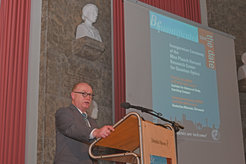In the kaleidoscope of quantum physics
Researchers at the Max Planck Institute of Quantum Optics (MPQ) and the Department of Physics of Harvard University, Cambridge, USA, will collaborate in the new Max Planck Harvard Research Center for Quantum Optics

Today, quantum optics is a multidisciplinary field, combining, for example, concepts from condensed matter physics and quantum field theory. To some extent, both institutions have complementary expertise, which is now brought together in the new center. Research topics at MPHQ range from the study of exotic quantum matter phases, quantum computing – based on scalable quantum networks or quantum simulation –, to quantum metrology and ultracold chemistry.
“The longstanding cooperation between the two institutions is being intensified by the new center,” says Gerhard Rempe from the Quantum Dynamics Division at MPQ, one the MPHQ’s co-directors. Besides Rempe’s division, the MPQ divisions ‘Quantum Many-Body Systems’ of Immanuel Bloch, ‘Theory’ of Ignacio Cirac, and the emeritus group ‘Laser Spectroscopy’ of Theodor W. Hänsch, also participate in the new endeavour. Harvard University’s Department of Physics contributes with the groups of John Doyle, Mikhail Lukin, Kang-Kuen Ni, and Eugene Demler.

“The new Max Planck Center brings together some of the worldwide leading teams in the field of quantum optics, allowing us to address some of the most outstanding questions in our field,” emphasizes Immanuel Bloch. “In particular, we want to support early career researchers, enabling them to form a unique scientific network. To this end, exchange programs and regular schools on quantum science are implemented in the cooperation agreement of the MPHQ.”
Among the current collaborative projects is one on the study of quantum many-body systems. “Here, the techniques developed in the fields of quantum information theory and condensed matter physics at MPQ and Harvard are being combined to address new challenges and describe physical phenomena that could not be accessed so far,” says Ignacio Cirac. Nobel laureate Theodor W. Hänsch is also enthusiastic about the new cooperation. “The Max Planck Harvard Research Center for Quantum Optics is creating synergies between research teams at both locations with complementary expertise and facilities. Our group, for instance, will participate with novel laser spectroscopy of atoms and molecules.”
18 Max Planck Centers worldwide
The Max Planck Centers constitute a substantial reinforcement of the Max Planck Society’s international cooperation efforts. They form platforms within the scientific cooperation programmes, where the participating Max Planck Institutes and their international partners can bundle their knowledge, experience, and expertise as well as combine complementary methods and knowhow to create added scientific value. Common projects, workshops, exchange programs, and schools shall create synergy effects that at the same time give a boost to existing research topics and trigger new research fields.
The second Max Planck Center with Harvard University has a targeted duration of six years. With the new Max Planck Harvard Research Center for Quantum, the number of Max Planck Centers worldwide is now 18. Both cooperation partners will contribute about 365,000 euros per year. OM/JE













